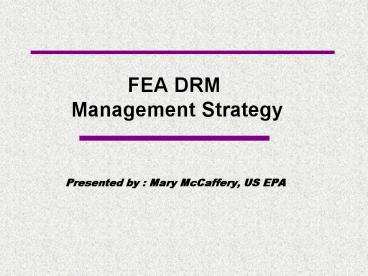FEA DRM Management Strategy - PowerPoint PPT Presentation
1 / 12
Title:
FEA DRM Management Strategy
Description:
NOTIONAL: FEA DRM Concept. Guiding Principles. Data is the businesses ... (Notional) Governance (A federalist approach that includes COI representatives ... – PowerPoint PPT presentation
Number of Views:36
Avg rating:3.0/5.0
Title: FEA DRM Management Strategy
1
FEA DRM Management Strategy
- Presented by Mary McCaffery, US EPA
2
Key Parts of the DRM Management Strategy
- DRM relationship to other FEA Reference Models
- DRM Purpose
- FEA DRM Concept
- Guiding Principles
- Enabling Factors
- Enabling Approach
- Critical Success Factors
3
.
The FEA inter-related reference models are
designed to facilitate cross-agency analysis of
investments and business functions, while
identifying opportunities for collaboration and
cost efficiencies
Federal Enterprise Architecture (FEA)
Performance Reference Model (PRM) Outcomes,
Measurements, Metrics
Business Reference Model ( BRM )
Service Component Reference Model ( SRM )
Technical Reference Model ( TRM )
Support Delivery of Services
Rule Publication
Technologies
Platforms J2EE .NET Windows NT
Knowledge Mgmt CRM Content Mgmt Collaboration Sear
ch Portal Personalization
Regulatory Development
Policy and Guidance Devel. Public Comment
Tracking Regulatory Creation Rule Publication
Data Mgmt ODBC JDBC Business Logic
Supporting technology and standards
Enabling capabilities, components, and services
Business lines and functions
Data and Information Reference Model
(DRM) Business Context, Data Classification /
Categorization, XML, Sharing
4
The DRM supports each of the other FEA
Reference Models
Data Reference Model (DRM)
- Maps data to inputs and outputs that support
Performance Outcomes - Maps data to processes by Lines of Business
- Maps data to Service Components by information
flows - Maps data to the infrastructure to plan for
interoperability
Performance Reference Model (PRM)
- Inputs, Outputs, and Outcomes
- Uniquely Tailored Performance Indicators
Business Reference Model (BRM)
- Lines of Business
- Agencies, Customers, Partners
Service Component Reference Model (SRM)
- Service Domains, Service Types
- Business and Service Components
Technical Reference Model (TRM)
- Service Component Interfaces, Interoperability
- Technologies, Recommendations
5
DRM Purpose
- The Data Reference Model provides a structure
that facilitates the development and effective
sharing of government data across communities of
practice and lines of business.
6
FEA DRM Concept
7
Guiding Principles
- Data is the businesses representation (or model).
A business activity may - Originate data
- Produce data
- Retain data
- Obtain data from or give data to other business
activities - Data should be designed to be shareable and
reusable - It is important for the business that it has a
common semantic understanding of the data - Data is a valuable business resource that must be
managed - Data and Information Stewardship responsibility
is necessary to support the mission of the agency - DRM processes must evolve over time and be
iterative
8
Enabling Factors
- Registry and process to maintain what data is
available with its associated metadata - Policies about what to register
- Initial Registration
- Harmonization and Standardization process
- Maintenance and updating of metadata
- Discovery process to find out what data is
available and where to get it
9
Enabling Factors Continued
- Process to measure achievement of business goals
related to data - Education of business and IT users
- Registry of information exchange agreements
10
DRM Enabling Approach(Notional)
Governance (A federalist approach that includes
COI representatives nominated from agencies and
E-Gov initiatives)
Collection Scope is info currently shared or
plan to share in a year. Participating
organizations create the DRM XML document in
conformance to the schema. Registration A DRM
Registry that is either federated or centralized.
Core.gov is a candidate. Harmonization
Governance identifies the business requirements.
Standardization This activity achieves semantic
understanding to support the business
requirement. Measure Were the business goals
achieved?
11
Critical Success Factors
- Strong and continuous executive management (OMB
and Federal CIO Council) - Understanding, attention, involvement, and
support including compliance, policies, and
enforcement methods - Strong and continuous Communities of Practice
(COP)/Lines of Business (LOB) understanding,
attention, involvement, and support
12
Critical Success Factors Continued
- Sufficient resources (people, time, and tools)
are provided by Communities of Practice
(COP)/Lines of Business (LOB) to adequately
perform the DRM tasks - Data standards are developed, adopted,
maintained, and adhered to by the COP/LOBs - Enabling tools, such as a Federal Data Registry,
are made available to engage COP/LOBs - Development and tracking of measures
13
Questions































